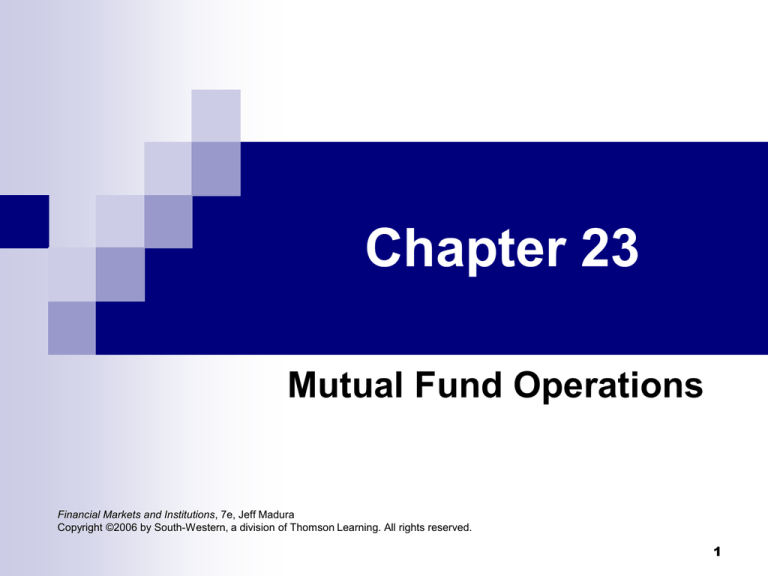
Chapter 23
Mutual Fund Operations
Financial Markets and Institutions, 7e, Jeff Madura
Copyright ©2006 by South-Western, a division of Thomson Learning. All rights reserved.
1
Chapter Outline
Background on mutual funds
Stock mutual fund categories
Bond fund categories
Growth and size of mutual funds
Performance of mutual funds
Mutual fund scandals
2
Chapter Outline (cont’d)
Money market funds
Hedge funds
Real estate investment trusts
Interaction with other financial institutions
Use of financial markets
Globalization through mutual funds
3
Background on Mutual Funds
Mutual funds:
Serve as a financial intermediary by pooling investments by
individual investors and using the funds to accommodate
financing needs by governments and corporations in the primary
market
Frequently invest in securities in the secondary market
Provide an important service for individuals who wish to invest
funds and diversify
Offer liquidity if they are willing to repurchase an investor’s
shares upon request
Offer various different services, such as transfers between funds
and check-writing privileges
4
Background on Mutual Funds
(cont’d)
A mutual fund hires portfolio managers to invest in a
portfolio of securities that satisfies the desires of
investors
The board of directors:
The portfolio composition is adjusted in response to changing
economic conditions
Monitors management
Establishes procedures
Ensures that the fund is properly serving its shareholders
Under new SEC rules, a majority of board members
must be outsiders
5
Background on Mutual Funds
(cont’d)
Types of funds
Open-end
funds:
Are open to investment from investors at any time
Allow investors to purchase or redeem shares at any time
Have a constantly changing number of shares
Maintain some cash in case redemptions exceed
investments
Consist of many different categories to satisfy investors’
investment needs
6
Background on Mutual Funds
(cont’d)
Types of funds (cont’d)
Closed-end
funds:
Do not repurchase shares they sell
Require investors to sell the shares on a stock exchange
Have a constant number of outstanding shares
Have an asset size that is about 1/40th of the asset size of
open-end funds
Focus primarily on bonds and other debt securities
7
Background on Mutual Funds
(cont’d)
Types of funds (cont’d)
Exchange-traded funds:
Are designed to mimic particular stock indexes and are
traded on a stock exchange
Differ from open-end funds in that their shares are traded on
an exchange, and their share price changes throughout the
day
Consist of a fixed number of shares
Are not actively managed
Have become very popular in recent years
Typically do not have capital gains and losses that must be
distributed to shareholders
8
Background on Mutual Funds
(cont’d)
Types of funds (cont’d)
Hedge funds:
Sell shares to wealthy individuals and financial institutions
and use the proceeds to invest in securities
Differ from open-end funds because:
They require a much larger initial investment
They may not always accept additional investments or
accommodate redemption
They are unregulated and provide very limited information to
prospective investors
They invest in a wide variety of investments to achieve high
returns
9
Background on Mutual Funds
(cont’d)
Comparison to depository institutions
Mutual
funds repackage the proceeds from
individuals to make various types of investments
Investing in mutual funds represents partial
ownership
Investors share the gains or losses generated by the fund
10
Background on Mutual Funds
(cont’d)
Information contained in a prospectus
The
minimum amount of investment required
The investment objective
The return on the fund over the past year, the past
three years, and the past five years
The exposure of the fund to various types of risk
The services offered by the fund
The fees incurred by the find that are passed on to
investors
11
Background on Mutual Funds
(cont’d)
Estimating the net asset value
The
net asset value (NAV) of a mutual fund indicates
the value per share
Estimated each day by determining the market value of all
securities comprising the fund, adding interest or dividends,
and subtracting expenses, then dividing by the number of
shares outstanding
12
Computing the NAV
Philly Mutual Fund has 50 million shares issued to its
investors. It used the proceeds to buy stock in 100
different firms. These shares have a market value of
$100 million. In addition, Philly incurred $7,000 in
expenses today and collected interest and dividends
totaling $5,000. What is the net asset value per share?
Net asset value Market value of fund/numbe r of shares
($100,000, 000 $5,000 - $7,000)/50 ,000,000
$99,998,00 0/50,000,0 00
$2.00
13
Background on Mutual Funds
(cont’d)
Distributions to shareholders
Mutual
funds generate returns to shareholders in
three ways:
They pass on earned income as dividend payments
They distribute capital gains resulting from the sale of
securities within the fund
Mutual fund share price appreciation
Mutual fund classifications
Stock
mutual funds, bond mutual funds, or money
market mutual funds (see next slide)
14
Background on Mutual Funds
(cont’d)
Distribution of Investment in Mutual Funds
17%
6%
50%
Stock Funds
Money Market Funds
Hybrid Funds
Bond Funds
27%
15
Background on Mutual Funds
(cont’d)
Expenses incurred by shareholders
Mutual
funds pass their expenses on to their
shareholders
Expenses can be compared among mutual funds by
comparing the expense ratio
Equal to annual expenses per share divided by the NAV
The higher the expense ratio, the lower the return for a given
level of performance
Mutual funds with lower expense ratios tend to outperform
others with similar objectives
16
Background on Mutual Funds
(cont’d)
Expenses incurred by shareholders (cont’d)
Expenses
include:
Compensation to the portfolio managers and other
employees
Record-keeping and clerical fees
Marketing fees
17
Background on Mutual Funds
(cont’d)
Sales load
Load
funds have a sales charge
Promoted by brokerage firms who earn a sales charge
between 3 and 8.5 percent
Investors pay the sales charge through the difference
between the bid and ask prices of the load fund
Front-end load versus back-end load
18
Background on Mutual Funds
(cont’d)
Sales load (cont’d)
No-load
funds are promoted strictly by the mutual
fund of concern
Preferred by investors who feel capable of making their own
investment decisions
Recently, some small no-load funds have become load
funds because they could not attract sufficient investors
19
Background on Mutual Funds
(cont’d)
Corporate control by mutual funds
Large
mutual funds can exert control over the
management of firms because they are commonly a
firm’s largest shareholders
e.g., Fidelity is the largest shareholder of more than 700
firms
Portfolio
managers of many funds serve on the board
of directors of various firms
Many firms discuss any major policy changes with
analysts and portfolio managers of funds to convince
them that the change will have a favorable effect
20
Stock Mutual Fund Categories
Growth funds are composed of stocks of maturing
companies that are expected to grow at a high rate
Capital appreciation funds are composed of stocks
that have high growth potential but may be unproven
The primary objective is to increase investment value
Suited to investors who are willing to risk a possible loss in
value
Growth and income funds provide potential for capital
appreciation with some stability in income
21
Stock Mutual Fund Categories
(cont’d)
International and global funds
International
funds invest in foreign securities
Returns on international funds are affected by the
foreign companies’ stock prices and the movements
of the currencies that denominate the stocks
Global funds include some U.S. stocks
22
Stock Mutual Fund Categories
(cont’d)
Specialty funds focus on a group of companies
sharing a particular characteristic
e.g.,
Index funds are designed to match the
performance of an existing stock index
e.g.,
energy or banking
Vanguard 500
Multifund funds invest in a portfolio of different
mutual funds to achieve more diversification
23
Bond Fund Categories
Income funds are composed of bonds that offer
periodic coupon payments and vary in exposure to risk
Corporate bonds are subject to credit risk, Treasury bonds are
not
Bonds backed by government agencies are less risky than
corporate bonds
Tax-free funds contain municipal bonds
Allows investors in high tax-brackets to avoid taxes while
maintaining a low degree of credit risk
24
Bond Fund Categories (cont’d)
High-yield (junk) bond funds consist of at least twothirds of bonds rated below Baa by Moody’s or BBB by
S&P
International and global bond funds
International funds contain bonds issued by corporations or
governments based in other countries
Global bond funds contain U.S. as well as foreign bonds
Foreign bonds are subject to credit risk, interest rate risk, and
exchange rate risk
25
Performance of Mutual Funds
Performance of stock mutual funds
The
change in performance of an open-end mutual
fund can be modeled as:
PERF f ( MKT , SECTOR , MANAB )
Change in market conditions
A mutual fund’s performance is closely related to market
conditions
The mutual fund’s beta can be used to measure the
sensitivity of the fund’s exposure to market conditions
26
Performance of Mutual Funds
(cont’d)
Performance of bond mutual funds
The
change in performance of an open-end mutual
fund can be modeled as:
PERF f ( Rf , RP ,CLASS , MANAB )
Change in the risk-free rate
Bond prices are inversely related to changes in the risk-free
interest rate
Bond funds focused on longer maturities are more exposed
to interest rate changes
27
Performance of Mutual Funds
(cont’d)
Performance of bond mutual funds (cont’d)
Change
Bond prices decline in response to an increase in the risk
premium
Poor economic conditions tend to increase the risk premium
Change
in the risk premium
in management abilities
The performance of specific bond classifications varies due
to differences in managers’ abilities
An efficient fund has low expenses and high returns
28
Performance of Mutual Funds
(cont’d)
Performance of closed-end bond funds
Driven by the same factors as open-end bond funds
Closed-end bond funds are also affected by a change in their
premium or discount
Performance from diversifying among mutual funds
The performance of any given mutual fund may be primarily
driven by a single economic factor
e.g., growth funds are highly dependent on the stock market’s
performance
Diversification across different mutual funds reduces
susceptibility to any particular type of risk
29
Money Market Funds
Money market funds:
Are
portfolios of money market instruments
constructed and managed by investment companies
Allow investors to participate for as little as $1,000
Usually allow check-writing privileges
Send periodic account statements to their
shareholders
Send shareholders periodic updates on any changes
in the asset portfolio composition
Sell some of their assets when redemptions exceed
sales
30
Money Market Funds (cont’d)
Risk of money market funds
Credit
risk is low, with the exception of commercial
paper defaults
Money market securities are not too sensitive to
movements in market interest rates
Expected returns on MMFs are low because of:
Low credit risk
Low interest rate risk
Consistently positive returns
31
Hedge Funds
Sell shares to wealthy individuals and financial
institutions and use the proceeds to invest in securities
Have historically been unregulated but are not allowed
to advertise
Are usually organized as limited partnerships
May allow investors to withdraw their investments but
require advance notice of 30 days or more
Often invest in derivative securities, sell short, or use
borrowed funds along with equity investments
Strive for high returns but also have a very high degree
of risk
32








